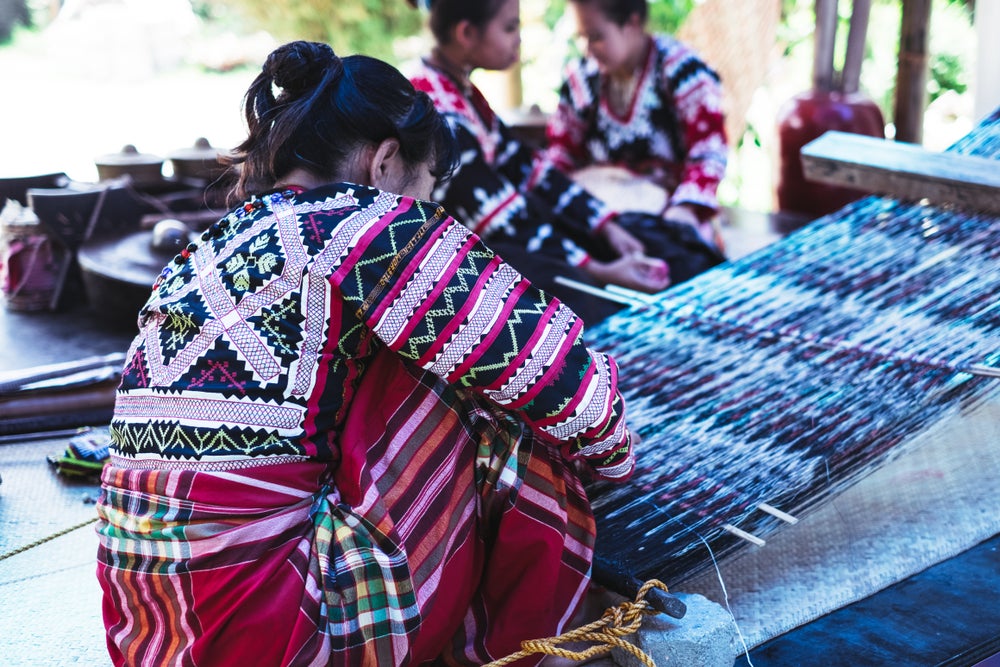
If there is no data, there is no story. That was the answer I received when arguing about the need to examine the intersectionality between ethnicity and gender to identify inclusion gaps among indigenous populations in the Philippines. We tend to forget that the combined impact of ethnicity, gender, and place of residence on inclusion can be far more damaging than the impact of gender alone.[1] There are between 370 and 500 million Indigenous Peoples (IPs) worldwide in over 90 countries. While they make up just 5 percent of the global population, they account for 15 percent of the extreme poor.
This global number gives us a slice of a sobering story, but geographically, there is much more to tell. For example, in Latin America, the identification of IPs is relatively unproblematic due to strong advocacy and administrative data collection efforts,[2] while in Asia, where a significant IP population lives, population figures are less clear and may fluctuate dramatically.[3]

This is the case in the Philippines, where despite the passing of the Indigenous Peoples' Rights Act (IPRA) in 1997, ethnicity variables were only introduced since the 2000 census. IPs in the Philippines are estimated at 10 to 20 percent of the 102.9 million national population, yet no official figure can be confirmed based on census data. Apart from census data, there is also a lack of IP-specific data in official surveys and administrative data in general. In cases where some data are available, IPs tend to be grouped under a single category according to geographical areas, ignoring the rich ethnolinguistic diversity existing across the country. While the commonly cited groups are the Cordillera people in the north and the Lumads people of the south, there are in fact more than one hundred IP groups in the Philippines. In fact, Lumad is an exonym that designates the eighteen or so ethnic groups indigenous to the southern island of Mindanao.[4] Rather than having the entire IP population reduced to homogenous groups, being recognized as multiple distinct cultural groups is part of the ongoing identity struggle of the IP communities across the Philippine archipelago.
In the Philippines, the lack of representation of IPs in official public data silences their voice and agency, limiting their ability to take on a more active role in society. It also reveals the existing inequality of opportunity for IPs to access basic services. The extent of this inequality is not well defined, as little research has been done examining the inequalities among and within ethnic groups in the country.[5] This represents a significant challenge when creating public policy at the national level or poverty reduction programs at the local level, as IPs remain unnoticed, unaccounted for, and ultimately deprived of any real benefit.
One of the few studies available highlights the importance of considering the intersection of ethnicity, gender, and place of residence to ensure successful outcomes for social service programs. The study, conducted by the University of the Philippines in 2017,[6] analyzed adjustments made to the Conditional Cash Transfer (CCT) program to accommodate the specific circumstances of IPs living in so-called Geographically Isolated and Disadvantaged Areas (GIDAs). Cultural beliefs about Western medicine and immunization were identified as major reasons for non-compliance with the conditions of the program. IP women expressed that certain health practices, such as notions of drinking cold water or taking a cold bath soon after giving birth, were contrary to their beliefs. IPs’ physical distance to health and education centers was also a major barrier to successful program delivery.

The lack of data on Indigenous Peoples is in itself the story that must be told. Furthermore, this lack should not then become a justification for further marginalizing these highly disadvantaged groups. Acknowledging the need for more and better data, the 2021 World Development Report (WDR) Data for Better Lives argues that “representing an entire population in a dataset is very difficult, and it’s often those who are disadvantaged that might be missed out. Marginalized people need better representation, and data systems must be designed with these challenges in mind.”
Counting IPs properly is only the first step to addressing the existing social inclusion gaps. We need to acknowledge that the lack of ethnicity variables in statistical databases, analytical tools, and reports represents a major barrier to recognizing and serving ethnic minorities in the country. We also need to work with government counterparts and other development partners to include ethnicity variables across official surveys and information systems to systematically collect, compile, and share IP data. Most of all, it is imperative to recognize that IPs matter. Going forward, the “no data, no story” perspective is no longer acceptable if we truly want to strive to end extreme poverty and promote shared prosperity in the Philippines and beyond.
[1] Inclusion Matters, World Bank, 2013.
[2] Indigenous Latin America in the Twenty-First Century, World Bank, 2015.
[3] World Indigenous Report, International Work Group for Indigenous Affairs, 2020.
[4] Oona Paredes, Between Rights Protection and Development Aggression, in Routledge Handbook of the Contemporary Philippines, 2017.
[5] Celia M. Reyes, Christian D. Mina and Ronina D. Asis, Inequality of Opportunities Among Ethnic Groups in the Philippines, Discussion Paper Series 2017-42, Philippine Institute for Development Studies, 2017.
[6] Assessment of the Modified Conditional Cash Transfer Program for Indigenous People in GIDAs, Department of Social Welfare and Development (DSWD) and UNICEF, 2017.


Join the Conversation